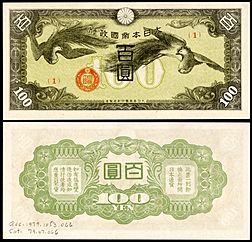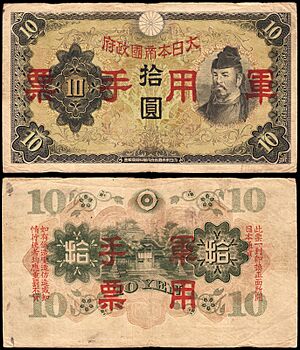Japanese military currency (1937–1945) facts for kids
Quick facts for kids Japanese military currency (1937–1945) |
|||
|---|---|---|---|
|
|||
| User(s) | Areas occupied by Japan during World War II | ||
| Subunit | |||
| 1⁄100 | Sen | ||
| Symbol | ¥ | ||
| Coins | None | ||
| Banknotes | 1 sen, 5 sen, 10 sen, 50 sen, ¥1, ¥5, ¥10, ¥100 | ||
Japanese military currency (also called gunpyo) was special money. The Imperial Japanese Armed Forces gave it to their soldiers as payment. This money became very common during the Pacific War. The Japanese government printed a lot of it for all the places they took over.
For example, in Hong Kong, people had to use this military yen. It was the only official money allowed. This military yen was not supported by gold, so it wasn't worth much outside the occupied areas. It also couldn't be traded for regular Japanese yen. By making people use this special money, Japan could control the economies in the places it occupied.
Contents
Money in Japanese-Controlled Areas
The areas that Japan controlled or took over had many different types of money. Taiwan kept its own banking system and banknotes after Japan took control in 1895. Korea did the same after 1910.
Between 1931 and 1945, Japan occupied large parts of China and Southeast Asia. They put several types of money into use there. In China, Japan set up governments that they controlled. Each of these governments printed their own money.
In Southeast Asia, the Japanese military printed banknotes. These notes had values in the local money, like rupees, pesos, or dollars. This special money is known as Japanese invasion money. Besides these, the Japanese military also printed their own banknotes, which were called yen. This was the Japanese military yen. In some places, like Hong Kong, the military yen became the official money.
How Japanese Military Yen Looked
In the late 1930s, some military yen looked like regular Japanese yen. But they had small changes. Thick red lines were printed over the name "Bank of Japan" (日本銀行). They also covered any text that promised to pay the holder in gold or silver.
Instead, large red words said "military currency" (軍用手票). This was to make sure people didn't confuse it with regular Japanese yen.
Later, in the early 1940s, the Japanese government made new military yen notes. These had special designs just for military money. They didn't copy existing Japanese yen notes. Instead, they featured new pictures like Onagadori cocks (a type of long-tailed chicken) and dragons.
All the later notes had a special message on the back. It said:
此票一到即換正面所開日本通貨。如有偽造、變造、仿造、或知情行使者均應重罰不貸。
This message meant: "This note can be exchanged for Japanese currency. Anyone who makes fake notes or uses them knowing they are fake will be severely punished."
The first military yen notes did not have serial numbers. They were printed without worrying about money losing its value. Later notes did have serial numbers. But near the end of the war, the military needed more money. So, they started printing notes without serial numbers again.
Military Yen in Hong Kong
The Hong Kong Government gave up to the Japanese Imperial Army on December 25, 1941. The very next day, the Japanese authorities made the military yen the official money of Hong Kong.
The Japanese occupation also made it illegal to use the Hong Kong dollar. They set a deadline for people to exchange their Hong Kong dollars for military yen.
When the military yen first came out on December 26, 1941, you could get 1 military yen for 2 Hong Kong dollars. But by October 1942, the exchange rate changed. You could only get 1 military yen for 4 Hong Kong dollars.
After getting Hong Kong dollars, the Japanese military bought supplies and important goods. They bought these from the nearby neutral Portuguese colony of Macao.
In 1944, Japan was struggling more in the war. The Japanese military in Hong Kong printed even more military yen. This caused the money to lose its value very quickly, a situation called hyperinflation.
Japan gave up the war on August 15, 1945. After this, British military authorities took control of the military yen banknotes. There was about 1.9 billion yen in total. However, the Japanese military had intentionally destroyed 700 million yen worth of it.
When Military Yen Became Worthless
On September 6, 1945, the Japanese Ministry of Finance announced that all military yen was now worthless. It became just useless pieces of paper.
Years later, on August 13, 1993, a group in Hong Kong tried to get their money back. They sued the Japanese government for the money they lost when the military yen became worthless. A court in Tokyo ruled against them on June 17, 1999. The court said that while it understood the suffering of the Hong Kong people, the government of Japan did not have specific laws about paying back military yen. Japan also used the Treaty of San Francisco, a peace agreement, as a reason to not pay compensation.
See also
- Japanese invasion money – Other types of money used in places Japan took over.
- Allied Military Currency – Money used by the Allied powers during World War II.
- Banknotes of the British Armed Forces – Money used by the British Armed Forces from 1946 to 1972.
- Military payment certificate – Money used by the U.S. military from the end of World War II to the Vietnam War.



